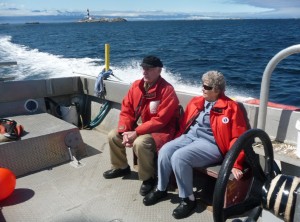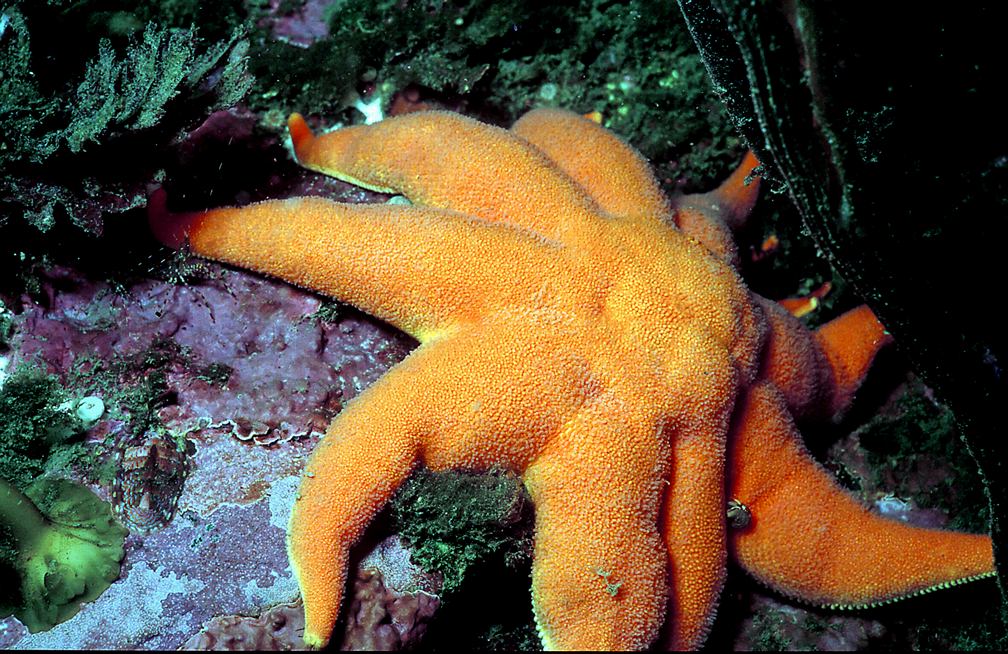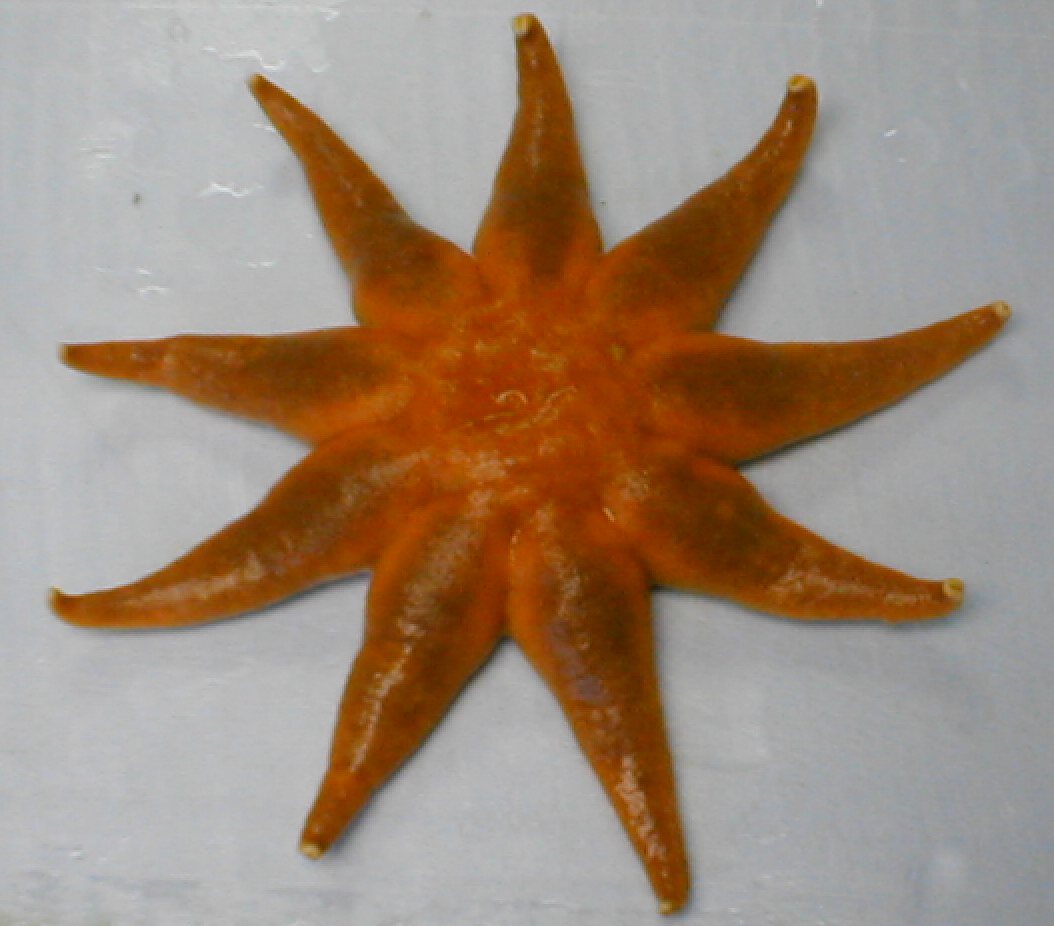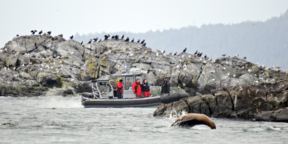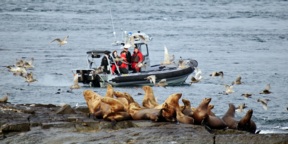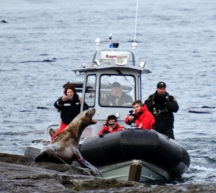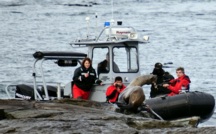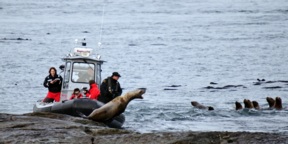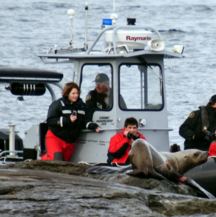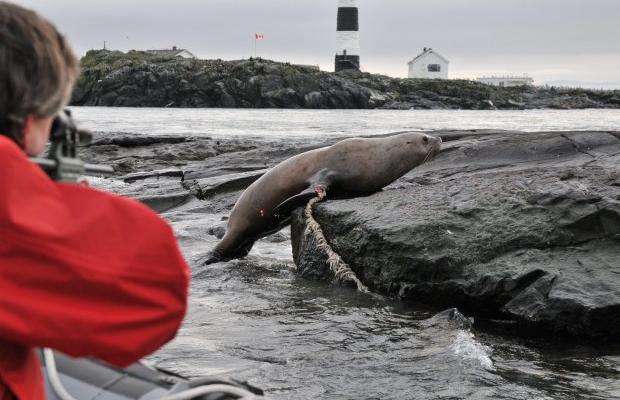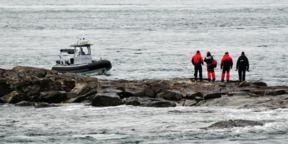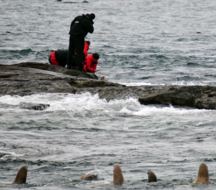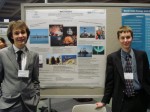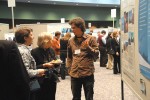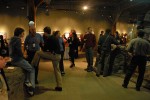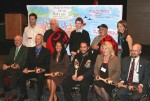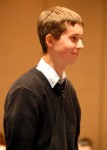Category Archives: Video
Race Rocks Ecological Reserve -Video
Elephant Seals: up close and personal video
Mike Robinson took this video of Misery today:
Get up close and personal with a Northern Elephant Seal at Race Rocks Ecological Reserve. Lots of facts and personal observations of these magnificent marine mammals, the second largest carnivore on the planet after their Southern cousins.
David Attenborough did this in depth video of Elephant Seals from Elephant Seals /Life in the Freezer/ BBC earth
Also this video Elephant sealls of Piedras Blacas , California by Brian Caserio iis very informative.
Pelican and Elephants Seals
The big adult male elephant seal (Mirounga angustirostris) is back from a few days excursion. Misery is looking sleek and healthy. The small female looks to be improving. The redness of her wounded eye is diminishing.
| Pelecanus occidentalis observed at Race Rocks |
Profile : Trev and Flo Anderson Connections with Pearson College 1976-1982
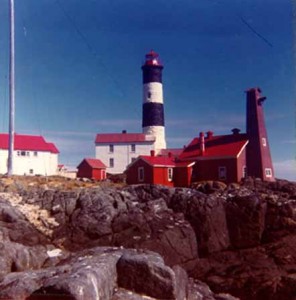 When Trev and Flo Anderson arrived at Race Rocks with their family in 1966, the old generator building was painted red and had a tall tower attached for the foghorn. By the mid-1970’s when we started coming out from Pearson College, the buildings were painted white. In 1978, the last of the wooden structures of the generator room were torn down and the present square block concrete building was erected.
When Trev and Flo Anderson arrived at Race Rocks with their family in 1966, the old generator building was painted red and had a tall tower attached for the foghorn. By the mid-1970’s when we started coming out from Pearson College, the buildings were painted white. In 1978, the last of the wooden structures of the generator room were torn down and the present square block concrete building was erected.
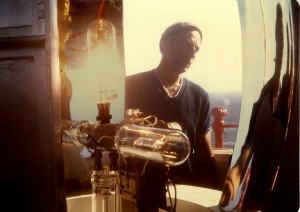 “When I first went over to Race Rocks in 1976, the light was made up of four 1000 watt bulbs, with one in the top position on at all times. When the bulb burnt out, it would automatically change positions with a new bulb. The light floated on a platform on a bath of mercury to reduce friction. Years later, Trev wonders how many light keepers were affected by the vapors given off from such mercury sources. In 1978, a beacon was installed that relied on more sophisticated electronics to send out a powerful beam . It wasn’t until after the Andersons left the station that the basin of mercury was replaced with a newer design with 8 beams. ( see lights file)
“When I first went over to Race Rocks in 1976, the light was made up of four 1000 watt bulbs, with one in the top position on at all times. When the bulb burnt out, it would automatically change positions with a new bulb. The light floated on a platform on a bath of mercury to reduce friction. Years later, Trev wonders how many light keepers were affected by the vapors given off from such mercury sources. In 1978, a beacon was installed that relied on more sophisticated electronics to send out a powerful beam . It wasn’t until after the Andersons left the station that the basin of mercury was replaced with a newer design with 8 beams. ( see lights file)
- This photograph published in the Times Colonist, (March, 2000), shows some architecture no longer present on the island: the tall fog-horn tower. The photo, taken by Gil Parker of Victoria shows the unique lines of the old engine room with the tower attached. Unfortunately this had to make way for modernization and was removed in 1977
- Demolition at Race Rocks: A film by Trev Anderson converted to digital video, showing the stone house originally built at the base of the tower and the wooden foghorn tower. Both were removed in the1960’s and 1970’s. This was taken before 1975 a view from the South side of the islands
- In 1977, Pearson College acquired a herring skiff for marine science and diving excursions. Here faculty members Garry Fletcher and John Wynne Hughes arrive at the island with students Charlie O’Neill and Andy Richmond on one of their earliest trips to the islands.
- We started to visit Race Rocks more frequently and the Andersons invited students to stay on project weeks. Andy and Bronwyn were among those who spent one such week on the island
- n 1977, PC students Alex, Edmond and Pierre were part of the group visiting on one occasion.
- In 1978, the herring skiff acquired a new fibreglass cabin , built by our Brazilian duo, Joao Luis and Anthony with help from many others. It was christened by them with the name “Ubatuba” after the beach of that name in Brazil meaning “big canoe” in a Northern Brazilian dialect
- Margaret, Kumene, Bartolomeo, Marta, Laurie and Soledad are a few of those recognized here
- Trev and Flo invited those of us who had worked so hard on the creation of the Ecological Reserve for Race Rocks in 1979 and 1980 to come to the island for the presentation of medals, ( I think it was “The Order of Race Rocks!”) Trev, Hans, Johan, Iina, Garry, Jens and Flo line up under the tower for this picture to mark that occasion.
- Trev and Flo helped us when the divers took local students from the public schools on our “Schools Project” field trips out to the Light Station.
- The many strips of wood which Trev glued together to make the hull
- A snow storm on the island, with winds from the North West.
- In one storm the plywood that was covering it blew away. It was for the Anderson’s a labor of love for the next seven years.
- Perseverance paid off, and in the spring of 1982, the “Wawa” was launched.
- If it had been durable enough to survive that, it would be a good bet to protect the Wawa as she was launched from that most precarious of locations into the seas of Race Passage. Building a 44 foot ketch by an amateur is hard enough on the mainland. Here, isolated on the rocks, it was even that much harder.
- After breaking the champagne bottle, Flo goes on board with Trev and no doubt could be heard to be saying “She does float after all!”
- The Red Ensign (coast guard version) which graced the bow had been the recognized Canadian flag until 1965. It was under this flag that Trev had served in the North African campaign with the RCAF on active service in the early 1940’s.
- Oded and Ricardo in the “banana boat” help tow the Wawa.
- Peter and others catch the lines as Wawa nears the docks
- Wawa in Pedder Bay
- After the fitting of the forward mast in Pedder Bay , the next stop was Vancouver for the fitting of the main mast.
- With masts and motor for full control, Wawa would return to Race Rocks for one last time to pick up the rest of Trev and Flo’s possessions that they would take with them aboard the boat.
- On their return to Pearson College, the Anderson’s spent many hours with our students aboard for shakedown cruises out of Pedder Bay.
- College director Jack Matthews accompanies the Andersons and students on one such outing.
- On one visit in the fall of 1982, Helen, Garry and Sarah Fletcher and Marc and Paul Marc Abrioux go out for a sail with Trev and Flo.
- Trev and Flo came by Taylor Beach for the year 3-4 ten year reunion in 1986. Marks McAvity, Anita and others were part of the group with the Wawa anchored off shore.
- Helen and Sarah talk to Trev and Flo on the docks at Pearson College.
- Flo Anderson has now written a book on their experiences entitled “Lighthouse Chronicles- Twenty Years on the BC Lights” See below for ordering information.
The book by Flo Anderson above is available from Harbour Publishing, P.O. Box 219 Madeira Park, B.C. V09-2H0
phone: 604-883-2730 fax: 604-883-9451 e-mail: harbour@sunshine.net To order direct from the publisher, pre-payment is required by cheque or Credit Card. GST for purchases in Canada, postage extra, No duty or GST in purchases from the US. Cost is $18.95(CAN)
 Link for this profile of Flo Anderson:
Link for this profile of Flo Anderson:
Flo Anderson was born in Victoria, B.C. She and her husband Trevor and their four children lived at five different B.C. lighthouse stations from 1961 to 1982. In December of 1961, her family left Vancouver to start life anew at the light station on Lennard Island, near Tofino. There wasn't a furnace. She used an old wood stove for heat and cooking, collecting driftwood for burning. She didn't meet anyone else on the island for weeks. "Writing about Lennard Island was very painful for me," she told interviewer Marianne Scott, "Life was traumatic. I was so naive. Recounting it all was therapy. Lots of people have this romantic view of living at a lighthouse. That's why I wrote about it." In 1963, Trevor Anderson became senior keeper at Barrett Rock, seven miles beyond Prince Rupert. Four months later they were sent to McInnes Island in Millbanke Sound, between Prince Rupert and Vancouver Island. Fourteen months later, they were relocated to northernmost staffed lighthouse in Canada, Green Island. In July of 1966 they were transferred to the southernmost point on the Canadian Pacific, Race Rocks, where they spent 16 years. As of 1974, they spent seven years building a yacht in whatever spare time they could find. "All the wives were part-time lighthouse keepers," she has recalled. "Unpaid, of course. It was just expected. When the man was away, the wife filled the gap." Trevor Anderson took early retirement in 1982, the year they launched their 44-foot wooden ketch, WaWa the Wayward Goose, circumnavigating Vancouver Island in 1983. For thirteen years they lived about their boat, once sailing as far as the South Pacific and New Zealand. Flo and Trevor Anderson came ashore in 1995 and now live in Sidney, B.C. At age 70 she wrote Lighthouse Chronicles: Twenty Years on the B.C. Lights (Harbour Publishing), published in 1988.
[BCBW 2003]
[BCBW WINTER 1998]
|
I In 2014 Trev and Flo celebrated their 70th wedding anniversary. At that time they still lived in Victoria BC. Flo Anderson passed away in 1997..https://www.racerocks.ca/flo-anderson-in-memoriam/ Trev celebrated his 100th birthday on October 22 , 2020 Trev had indicated that he had donated several artifacts from Race Rocks to the BC Maritime museum so we went in search of those items on May 22, 2014: |
Article in Pacific Yachting magazine by Marianne Scott on Trevor Anderson 2019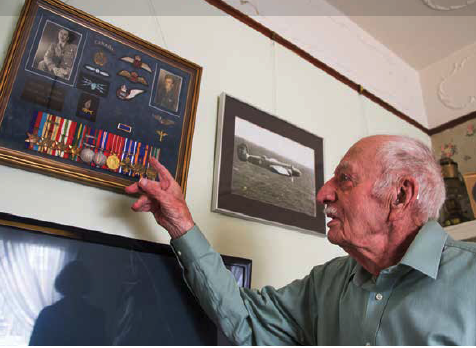
Flood Current at Race Rocks
Solaster endeca: Northern Sun star
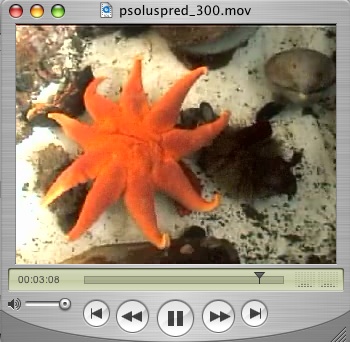 One of the frames from the video on predation on the Psolus chitinoides
One of the frames from the video on predation on the Psolus chitinoides
Predation of a Psolus chitinoides by a sea star is examined and discussed by Laura and Nadege. The stomach of the sea star surrounds the sea cucumber and the soft neck and mouth of Psolus is well inside the cavity of the sea
We see these occasionally at Race Rocks in the subtidal areas.Their favorite prey are various species of sea cucumber. Their puffy arms distinguish them from other orange stars. They can grow to 40 cm. across.
- photo by Dr. Armin Svoboda
Reference: Lamb and Hanby, Marine Life of the Pacific Northwest.
| Other Members of the Phylum Arthropoda at Race Rocks |
and Image File |
 The Race Rocks taxonomy is a collaborative venture originally started with the Biology and Environmental Systems students of Lester Pearson College UWC. It now also has contributions added by Faculty, Staff, Volunteers and Observers on the remote control webcams. The Race Rocks taxonomy is a collaborative venture originally started with the Biology and Environmental Systems students of Lester Pearson College UWC. It now also has contributions added by Faculty, Staff, Volunteers and Observers on the remote control webcams.
G.Fletcher
|
Entangled Sea Lion gets rescued at Race Rocks
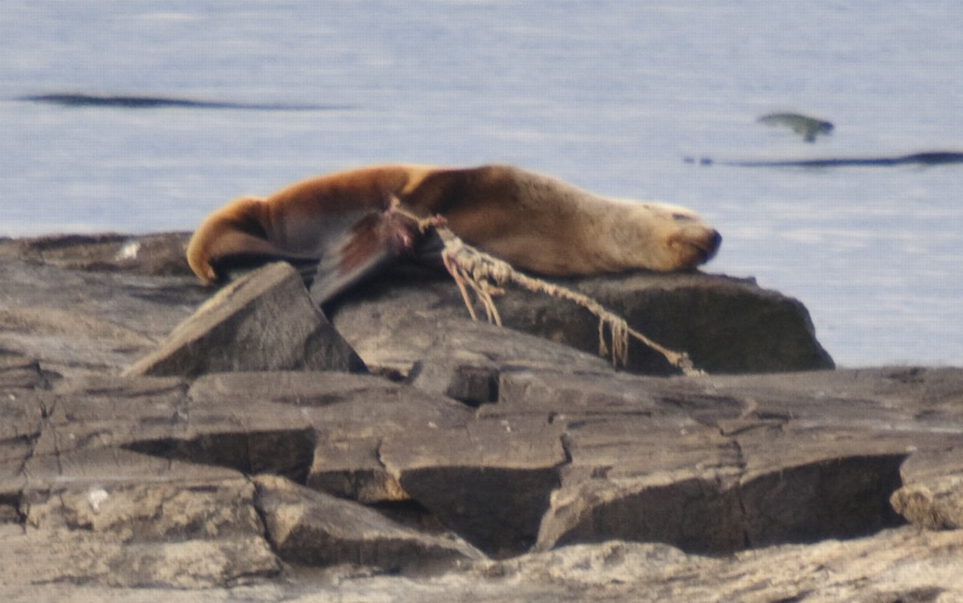
The rope had his right flipper ensnared, and it was caught on a rock leaving him tethered on the island
On December 13, 2009, Ecoguardian Ryan Murphy reported to DFO that a sea lion on Middle Island was entangled in ropes. (See Ryan’s comments below) The ropes were snagged so it could not leave the rock. A rescue was mounted by DFO and the Marine Mammal Rescue Centre of the Vancouver Aquarium on December 16. This was the first time a sea lion had been successfully released from such an entanglement.
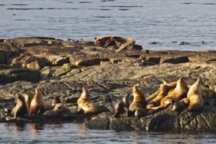 |
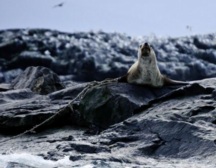 |
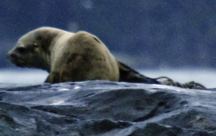 |
| On December 14 he was still there | Location of the animal (top of picture) on Middle Island | A tangle of ropes had him snared so that he could go in and out of the water but not very far. |
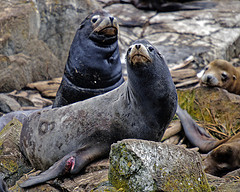 See these other images by Ryan of injured marine mammals that haul out at Race Rocks .
See these other images by Ryan of injured marine mammals that haul out at Race Rocks .
Puget Sound Partnership-Pearson College Participates
- Ryan and Radu at the Poster presentation.
- Radu and Adam at Race Rocks Poster
“The biennial Puget Sound Georgia Basin Ecosystem Conference is the largest, most comprehensive scientific research and policy conference in the Salish Sea region. The 2009 conference, hosted by the Puget Sound Partnership and Environment Canada, built upon the experience of previous conferences by connecting scientific research and management techniques to priorities for meaningful action. The 2009 conference theme was The Future of the Salish Sea: A Call to Action. Since 2003, the conference has moved from chronicling science research to exploring the science/policy interface. The 2009 conference theme captured this progression from sound science to informed action. Conference participants had the opportunity to apply shared knowledge by developing priorities and a commitment to post-conference engagement.
Conference sub-themes included:
Air Quality & Climate Change
Ecosystem Management Strategies and Techniques
Habitat, Land Use, and Species
Marine & Freshwater Resources “
Adam Harding presented The Pearson College-EnCana-Clean Current Tidal Power Demonstration Project at Race Rocks
Photos: http://www.flickr.com/photos/designer_psp/collections/72157613549032493/
Videos:
http://www.psp.wa.gov/videos/mediaplayer/video_library_psgb.php
Publications:
http://gristmill.grist.org/story/2009/2/10/145023/460http://gristmill.grist.org/story/2009/2/6/16054/64735
- Ryan and Radu at the Poster presentation.
- Ryan explaining the Race Rocks Poster
- Adam and Radu in discussion with conference participants
- Adam served on the panel on energy.
- Adam being presented with a token of appreciation for his presentation.
- Adam as part of the witness group.
- Adam Harding
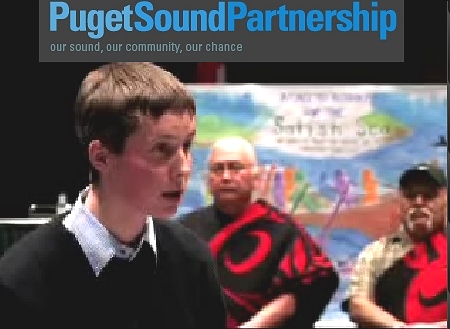
A video from the Puget Sound Partnership Conference with Adam Harding presenting the Call to Action in the Day 3 Closing Session. Click to start.
For the complete set of video of the plenary sessions see this link:
http://www.psp.wa.gov/videos/mediaplayer/video_library_psgb.php
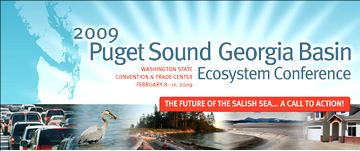
The complete text of the video above “A Call To Action for the Salish Sea.”. Developed by the Call to Action Team at the 2009 Puget Sound Georgia Basin Ecosystem Conference. Read aloud in closing plenary by Adam Harding, Pearson College, on Wednesday, February 11th, 2009 (PDF)
Slash and Sleep Apnea
Slash the elephant seal male was having a good sleep in the morning behind the boathouse.
I took this video clip of our resident elephant seal “Slash” asleep in one of his favourite spots behind the boathouse at Race Rocks. At 8:00 am he was in a deep sleep, interrupted only by the kelp flies on his face and a few itchy spots on his body. What was remarkable was the recurring pattern of breath holding. I made this video as a study of this aspect of what appears to be intentional sleep apnea. Since the filming was uninterrupted, one can time the various phases of a breathing cycle. Labels on the video point out the beginning and end of one such breath-holding cycle. I observed that he repeated a similar pattern for at least 15 minutes, the length of time I as was able to observe. GF.
Listen for the sounds and watch for the flaring nostrils.
You can see more elephant seal images and videos in the Elephant Seal Taxonomy.

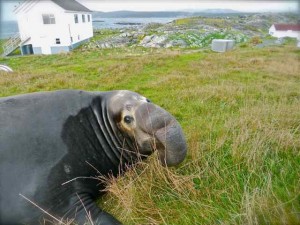


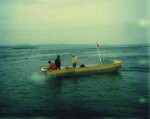
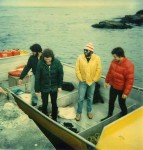
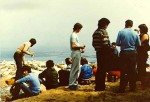
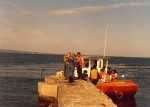
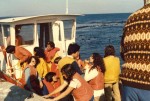

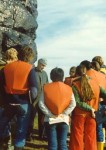

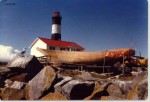


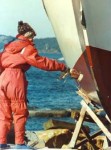

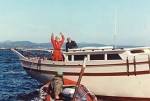
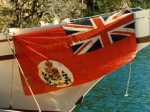
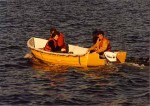


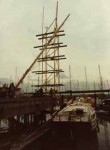

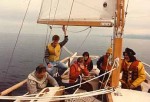
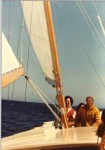
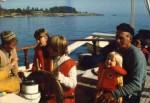
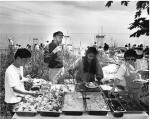
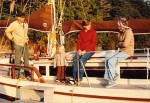
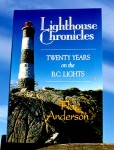
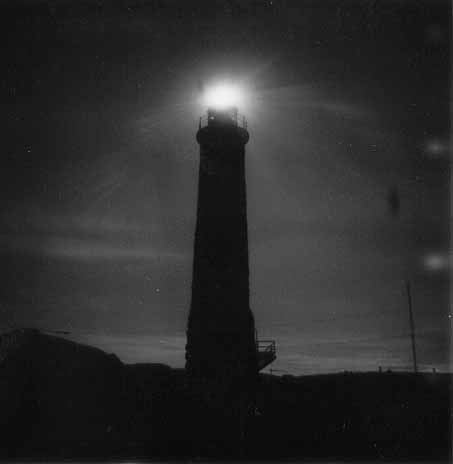
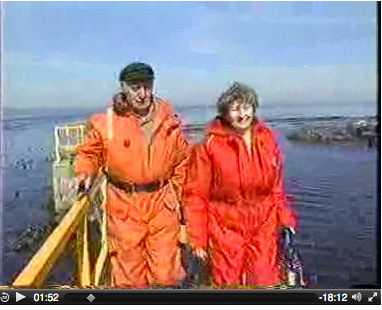 Trev and Flo return to Race Rocks for a visit and an
Trev and Flo return to Race Rocks for a visit and an